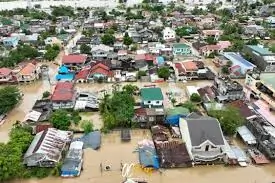Typhoon Trami (Kristine) was a powerful and intense tropical cyclone that impacted parts of East Asia, bringing heavy rainfall, strong winds, and widespread disruptions.
ADVERTISEMENT

Table of Contents

Typhoon Trami (Kristine)
Typhoon Trami (Kristine) left a profound impact on the Philippines, especially in the wake of its torrential downpours and powerful winds that battered the region in late October 2024. This Category 4 typhoon inflicted significant damage as it swept through the country, with wind speeds exceeding 130 mph (210 km/h), uprooting trees, damaging power lines, and causing widespread power outages across affected provinces. The Bicol region, which bore the brunt of the storm, faced overwhelming flooding that submerged homes and roads, isolating communities and making emergency responses challenging.
Landslides triggered by the relentless rainfall destroyed critical infrastructure, further complicating efforts to deliver aid and restore access to essential services. The agricultural sector was heavily impacted, with thousands of hectares of crops destroyed, threatening food security and economic stability for local farmers. Relief agencies, both local and international, have mobilized to distribute food, clean water, and medical supplies to those displaced by the storm.
Recovery from Typhoon Trami (Kristine) is expected to be a long process, as authorities focus on rebuilding homes, rehabilitating public infrastructure, and implementing measures to strengthen disaster resilience in vulnerable areas. The typhoon’s devastating effects have reignited discussions on climate change and its role in intensifying the frequency and severity of tropical cyclones in the region, emphasizing the importance of sustainable and proactive disaster preparedness.
Here’s an expanded breakdown of each section, diving deeper into each topic for a comprehensive view of Typhoon Trami (Kristine).
I. Introduction
Overview of Typhoon Trami (Kristine):
Typhoon Trami, referred to as “Kristine” in the Philippines, was a powerful Category 4 typhoon that struck the nation in late October 2024, leaving a trail of devastation across various regions. Known for its exceptional wind speeds and torrential rains, Trami gained attention for its rapid intensification and potential linkage to global climate trends. It represents one of the most severe natural disasters of the season.
Context and timing:
The typhoon arrived at the height of the Western Pacific’s typhoon season, a period that often brings severe weather to Southeast Asia. Occurring amidst ongoing discussions on climate resilience, Typhoon Trami underscored the urgency of addressing infrastructure, disaster preparedness, and community safety during peak typhoon seasons.
Importance and scope:
Understanding the impact of Typhoon Trami goes beyond immediate relief efforts; it is an essential case for examining disaster preparedness, emergency response, and the socioeconomic consequences of such events. The storm’s devastation also brings to light issues of climate vulnerability and the need for adaptive strategies.
II. Formation and Path
Meteorological origins:
Trami began as a low-pressure disturbance in the Western Pacific, encountering favorable conditions for growth, including warm sea surface temperatures and low vertical wind shear, which allowed it to intensify quickly.
Development stages:
The storm evolved from a tropical depression to a tropical storm and ultimately reached Category 4 intensity. Each stage involved specific atmospheric and oceanic conditions that increased its power, with scientists monitoring changes in wind speeds and atmospheric pressure that signaled its intensification.
Path of the typhoon:
Trami’s route was tracked closely by meteorological agencies as it moved across the Pacific towards the Philippines, raising alarms for its potential impact. The typhoon’s trajectory gave insights into the seasonal movement of such storms and highlighted regions at risk.
Weather forecasting and early warnings:
Agencies like the Philippine Atmospheric, Geophysical and Astronomical Services Administration (PAGASA) issued warnings, updating forecasts as Trami approached. Forecast adjustments highlighted the importance of accurate prediction models to mitigate risks and prepare communities adequately.
III. Impact on Affected Areas
Geographic focus:
The most heavily impacted areas included Bicol and Northern Luzon, regions that faced extensive flooding and destruction. Each region’s topography influenced the extent of damage, with low-lying and coastal areas experiencing more severe flooding and rural, mountainous regions facing landslides.
Meteorological data:
The typhoon brought extreme winds exceeding 130 mph (210 km/h) and heavy rainfall that reached unprecedented levels in some areas. Data on peak rainfall helped authorities assess the risk of flooding in certain areas, while wind-speed information was crucial for understanding structural damage potential.
Nature of damage:
Flooding submerged homes and roads, while landslides destroyed infrastructure, especially in rural areas. The extent of submersion varied, with some communities experiencing water levels high enough to isolate them for days.
Comparative impact:
When compared to previous storms, Trami (Kristine) proved to be one of the most severe typhoons in recent years. This comparison provides a historical perspective, showing trends in storm intensity and helping communities and authorities prepare for future events.
IV. Humanitarian Toll
Death and injury statistics:
Typhoon Trami resulted in 85 confirmed fatalities, with 41 people reported missing, underscoring the storm’s human toll. Data on injuries and fatalities highlight areas where safety protocols and evacuation plans may need improvement.
Displacement and evacuations:
Over 150,000 people were forced to evacuate, with many relying on evacuation centers for safety. The living conditions in these shelters varied, with overcrowding and shortages of essentials presenting ongoing challenges.
Personal stories:
Survivor accounts revealed the emotional and psychological effects of the disaster, from the fear of losing loved ones to the trauma of seeing homes destroyed. These stories are essential for understanding the personal impact and resilience of affected populations.
Demographic impact:
Vulnerable groups, including children, the elderly, and those with limited resources, faced the greatest hardships. Assessing the demographic impact helps authorities identify groups that may need additional support during recovery.
V. Damage and Destruction
Infrastructure details:
Key infrastructure, including roads, bridges, and public facilities, suffered significant damage. For instance, major highways connecting rural areas to cities were obstructed by debris and landslides, hindering relief efforts.
Residential impact:
Thousands of homes were destroyed, and many more sustained damage, leaving families homeless or facing extensive repairs. Efforts to document and assess housing damage were essential for organizing relief and rebuilding projects.
Agricultural and economic consequences:
The storm decimated farmland, including rice paddies and cornfields, impacting food supply and the income of local farmers. Additionally, fisheries were severely affected as boats and equipment were damaged, threatening the livelihoods of fishing communities.
Sector-specific damage:
Schools, hospitals, and water supply systems faced varying degrees of damage, disrupting essential services. The impact on these sectors affected both immediate needs and longer-term recovery, particularly in education and healthcare.
VI. Emergency Response and Relief Efforts
Government response:
The Philippine government and local authorities launched immediate response measures, including search and rescue missions, and declared states of emergency to speed up resource allocation.
NDRRMC role:
The National Disaster Risk Reduction and Management Council coordinated relief efforts, working with regional agencies to dispatch teams and resources to affected areas.
NGO and international aid:
International organizations and NGOs provided critical assistance, including food, shelter, and medical supplies. These partnerships eased the resource burden on local governments.
Logistics of aid distribution:
Delivering aid proved challenging in areas cut off by flooding and landslides. Authorities used helicopters, boats, and land vehicles to reach isolated communities, demonstrating the logistical complexity of disaster response.
Community-led initiatives:
Local volunteer groups organized relief efforts, with individuals helping to distribute food, water, and clothing. These initiatives exemplified the spirit of community solidarity and resilience.
VII. Long-Term Recovery and Rebuilding
Infrastructure recovery plans:
Authorities prioritized rebuilding critical infrastructure like roads and bridges, aiming to restore connectivity. Timelines and budgets for reconstruction were established to coordinate efforts across affected regions.
Housing reconstruction efforts:
Rebuilding homes was a top priority, with temporary shelters provided for those displaced. Long-term housing solutions included government-funded projects and NGO assistance.
Economic support for affected populations:
To support local economies, authorities offered financial aid and grants to farmers and small businesses. The goal was to help communities regain financial stability and rebuild their sources of income.
Health initiatives:
Long-term medical care, particularly mental health support for trauma victims, became part of the recovery plan. Community health workers provided ongoing care and conducted health assessments.
Education sector recovery:
Authorities established temporary learning centers to prevent disruptions in schooling. Plans for rebuilding damaged schools included new safety measures to withstand future disasters.
VIII. Challenges Faced in Response and Recovery
Accessibility issues:
Inaccessible roads and flood-blocked areas delayed relief efforts, highlighting the need for infrastructure that can withstand extreme weather.
Resource constraints:
Financial and material shortages posed challenges for maintaining aid distribution, especially in more remote locations.
Coordination difficulties:
The sheer number of agencies involved in the response created communication challenges, underscoring the need for streamlined coordination.
Sustainability of aid:
Ensuring long-term support was a challenge, as resources began to dwindle in extended recovery phases. Sustainable support systems are critical to maintain efforts over time.
Subsequent weather events:
Continuous rainfall and the threat of another storm disrupted ongoing relief operations, complicating logistics and heightening concerns of additional damage.
IX. Lessons Learned and Future Preparedness
Evaluating response strategies:
Assessment of the disaster response revealed areas for improvement, including faster evacuation procedures and better pre-disaster communication.
Investments in resilient infrastructure:
Emphasis on storm-resistant buildings and flood defense systems to reduce vulnerability to future typhoons.
Public readiness programs:
Expanded educational campaigns aimed at teaching communities how to respond to disasters, with a focus on practical drills and planning.
Policy recommendations:
Recommendations included policy changes to allocate more funds for disaster preparedness and to mandate stricter building codes.
Innovation in technology:
Utilizing new technologies, such as early warning systems and real-time satellite monitoring, to enhance forecasting accuracy and response efficiency.
X. Climate Change and Typhoon Intensity
Scientific perspective:
Studies indicate that climate change may be causing more intense tropical cyclones. This section would include data on how warming sea temperatures and other factors contribute to stronger storms.
Historical trends and data:
Analysis of typhoon patterns over recent decades reveals an upward trend in storm intensity, supporting calls for action on climate adaptation.
Environmental policies:
Discussion of environmental policies and their potential impact on climate resilience, including emissions targets and renewable energy initiatives.
Adaptation measures:
Review of climate adaptation strategies, such as developing typhoon-resistant infrastructure and creating buffer zones to mitigate flood damage.
Call for international cooperation:
Highlighting the importance of global collaboration to support climate adaptation in vulnerable regions like Southeast Asia.
Conclusion
Typhoon Trami (Kristine) stands as a stark reminder of the destructive potential of natural disasters and the vulnerabilities faced by communities in typhoon-prone regions. The storm’s devastation, with its high death toll, widespread displacement, and immense damage to infrastructure and livelihoods, underscores the importance of robust disaster preparedness, responsive emergency management, and long-term resilience planning. The collective efforts of government agencies, NGOs, and local communities showcased commendable resilience and quick action, but also revealed gaps in coordination, resource availability, and infrastructure readiness that need addressing.
Recovery from Trami is ongoing, marked by efforts to rebuild homes, restore essential services, and provide long-term support to affected populations. This typhoon has also reignited critical discussions about climate change’s role in intensifying natural disasters, emphasizing the need for sustainable and forward-thinking adaptation measures.
The resilience of the affected communities and their determination to rebuild serves as a testament to the strength of the human spirit. Yet, Typhoon Trami’s legacy must be more than just a memory of loss and recovery; it must propel continued investment in stronger infrastructure, comprehensive disaster preparedness programs, and global cooperation to mitigate the effects of climate change. Through these lessons and actions, communities can better protect themselves against future storms and safeguard their future.
Disclaimer
This document is intended for informational purposes only and is based on data and reports available at the time of writing. While every effort has been made to ensure the accuracy and reliability of the information presented, new developments or revisions in data may arise as recovery efforts continue and further assessments are conducted. The content does not replace official reports or advice from government agencies, meteorological services, or disaster response organizations.
Readers are encouraged to consult official sources and expert guidance for the most up-to-date and detailed information regarding Typhoon Trami (Kristine) and related recovery efforts. The author and publisher of this document are not liable for any damages or losses arising from the use or interpretation of the information provided.
About Author
Kween Yulo is a seasoned SEO writer with 15 years of experience, specializing in diverse niches across the digital landscape. Her expertise spans various industries, including gaming, e-commerce, finance, travel, and lifestyle. Known for crafting engaging, optimized content, Kween’s writing is tailored to boost search rankings and enhance user engagement. Her deep understanding of SEO trends, keyword strategies, and audience behavior has made her a trusted content creator for businesses seeking to strengthen their online presence. Kween’s versatility and dedication to quality make her an asset in any digital content strategy.


